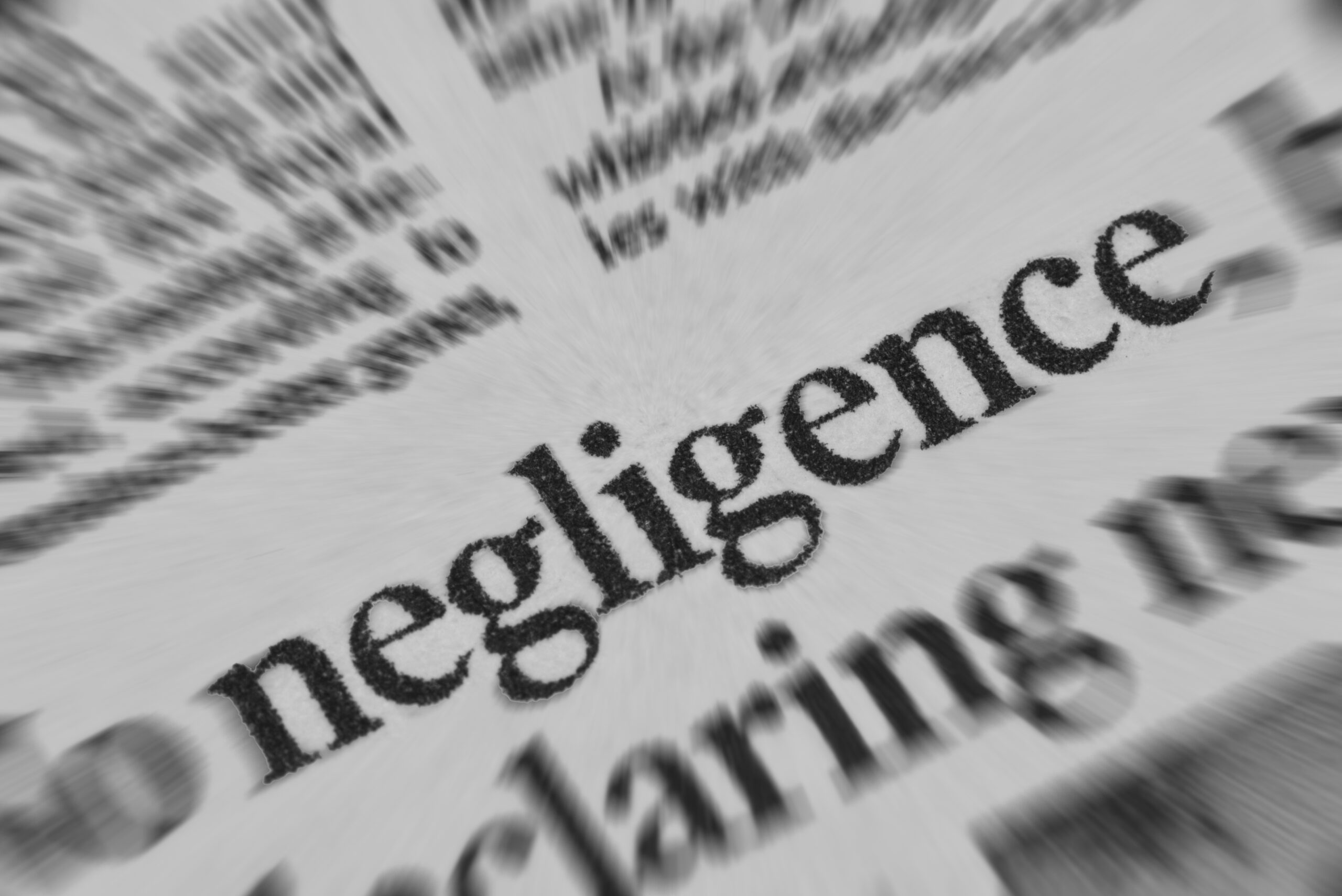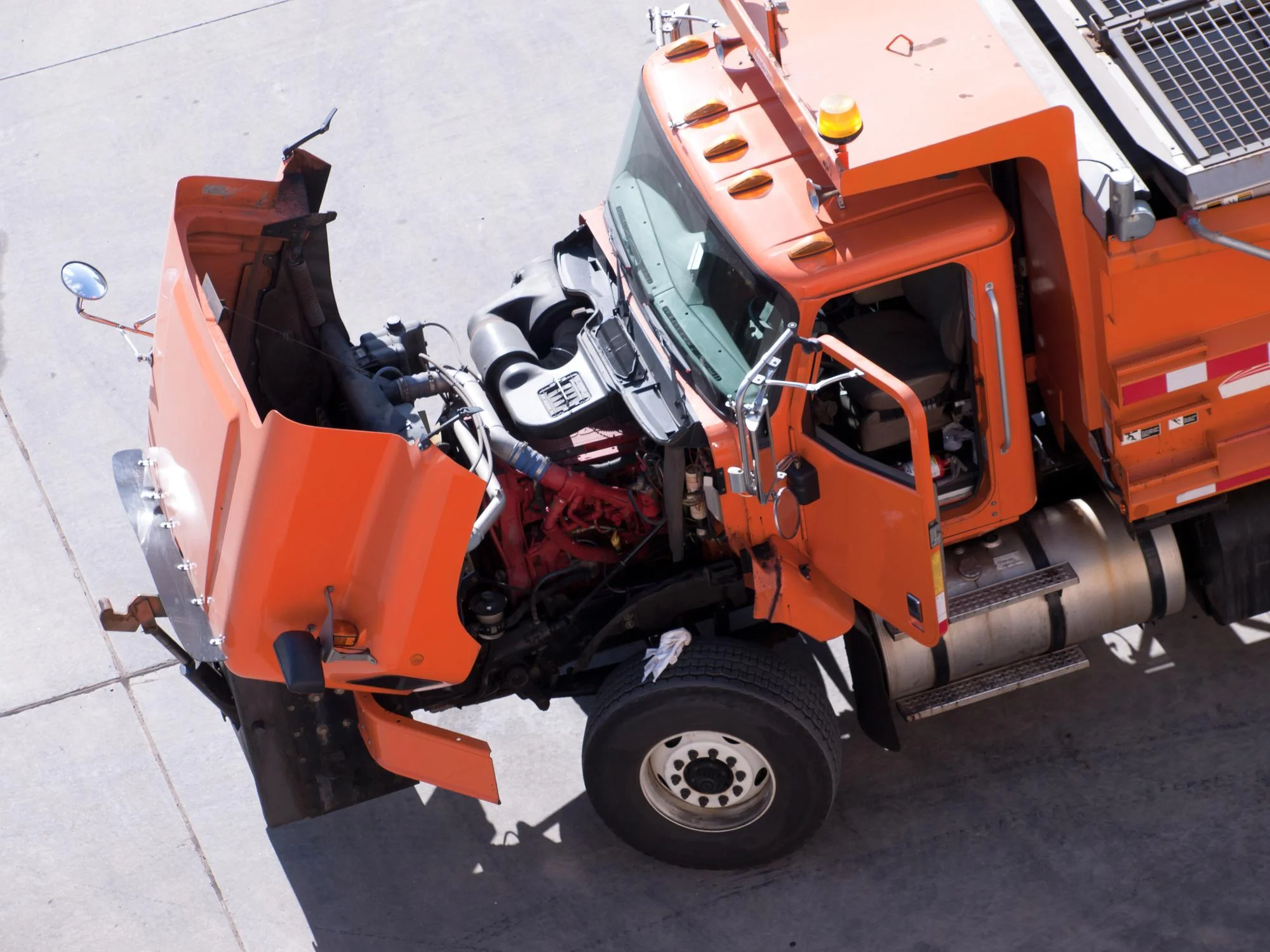When someone is injured due to the actions of another person, they may decide to file a personal injury claim in order to receive compensation for their damages. In order to prove that the other person was negligent, the plaintiff must prove that the defendant owed them a duty of care, that they breached that duty, that the breach of duty was the main reason for the accident, and that the accident resulted in real damages.
What is Negligence?
In personal injury cases, negligence is the word used when claiming that someone is to blame or liable for the injury that occurred. Being negligent generally involves acting recklessly or failing to act in a reasonable manner which results in someone else being harmed. There are many examples of the way someone might be negligent, such as:
- A landlord not replacing broken railings
- A store not having ‘wet floor’ signs out after mopping
- Someone driving while drunk
- Someone letting their dog off-leash
- A doctor prescribing medication that should not be mixed
In a Negligence Case the Plaintiff Must Establish the Following Elements
There are four factors involved in a personal injury caused by negligence [1]:
- Duty of care
- Breach of duty
- Causation of injuries
- Damages sustained
All of these factors are interlinked and must be true in order to have a viable claim. Real harm or damages must be suffered due to the incident, which must have been the result of a breach of duty of care owed to the plaintiff by the defendant. If any one of these is not present, a personal injury claim falls apart. If there is no duty of care owed, then they are not liable. If there was no breach of duty, then they were not negligent. If there was a breach of duty, but that was not the cause of the accident, then they were not liable. If there was a breach of duty that caused an accident, but there was no damage, then there is nothing to claim.
Duty
The number one thing to establish when determining liability is if there was a duty of care owed to the injured party by the accused party. This can be a direct duty such as a doctor owes to their patient or a general duty such as a driver owes to everyone around them. When someone owes someone else a duty of care, it is their responsibility to act reasonably in fulfilling that duty.
What is Reasonable Care?
When the law talks about what is reasonable, it means what would be expected of anyone in the given situation [2]. It is generally the bare minimum requirement and often amounts to common sense and basic courtesy. The average person owes a reasonable level of care to the people around them in many ways:
- Drivers have a duty to avoid causing others bodily harm or property damage
- Dog owners have a duty to keep their dog from biting anyone
- Homeowners have a duty to make their property safe for guests
Some people are set to a higher standard of care, generally due to professional standards and/or personal relationships:
- Doctors
- Public Transport Drivers
- Store Owners
- Manufacturers
How to Determine Whether There Was a Duty to Act
There is no uniform way to establish if someone had a legal duty to act, but there are many common angles to consider, such as:
- Was the defendant involved in the creation of the risk that caused the incident?
- Did the defendant voluntarily, explicitly or implicitly agree to keep the plaintiff from being harmed?
- Did the defendant know, or should they reasonably have known that their action or inaction would cause harm?
- Did the defendant and plaintiff have some kind of official or professional relationship that included a duty of care?
- Would any reasonably prudent person in the defendant’s position have behaved the same way?
Breach of Duty
Individuals who have a duty of care are expected to fulfill that duty to the extent that any reasonably prudent person would. This means the average person with average common sense and the knowledge expected of any average person in their position. A reasonably prudent person with a driver’s license would follow the rules of the road and not drive while intoxicated. A reasonably prudent store manager would know if there was water all over the floor of the entranceway and would have an employee put out signs and mop up. If someone has a duty of care and does not behave as a reasonably prudent person would, it may be considered to be a breach of that duty and they may be guilty of negligence.
How to Determine a Breach in Duty
In the 1947 case United States v. Carroll Towing [3], Judge Learned Hand devised a formula:
B < PL = Negligence Liability
- B – Burden
- P – Probability
- L – Loss
This means that if the burden of taking appropriate precautions to avoid the damage was less than the probability and personal cost of the damage, then the party responsible for taking precautions would be liable.
Causation
It is not enough to prove that the defendant had a duty of care that they then breached. The plaintiff must also prove that the defendant’s negligence was the main cause of the incident and the resulting injuries. The most common way to establish this is to consider what would have happened if the defendant had acted differently. It is also important to consider if the defendant could have or should have known about the potential for any damages that could result from their action or inaction.
For example:
Sam is a store owner who knows it is raining but has not taken precautions to keep the entranceway dry or warn customers that the area is slippery. A customer comes in and slips and falls at the front of the store, spraining her ankle. At the back of the store, a customer drops a glass bottle of oil, and it breaks, spilling all over the floor. The customer immediately slips and breaks his elbow. Seconds later, another customer comes around the corner and slips as well, getting a concussion. Sam has breached his duty of care to his customers by allowing a slipping hazard at the front of the store. He is liable for the first injury. However, his negligence is not the cause of the injuries at the back of the store. The customer who dropped the bottle created the risk and both injuries happened before Sam could be expected to know that there was a hazard.
Damages
In order to be awarded compensation, there must be some kind of damage associated with the accident to compensate. Damages incurred from a personal injury can include but are not limited to:
- Hospital Bills
- Loss of Income
- Medication Costs
- Pain and Suffering
- Emotional Distress
- Disability & Disfigurement
- Decreased Quality of Life
How to Determine if Injury Occurred
Determining if injuries occurred is normally relatively easy. Quantifying the level of damages is usually the complicated part. That said, in order for injuries to meet the necessary standards of a personal injury lawsuit, there must be physical bodily harm. This is normally proven when the plaintiff suffered harm that is visible. Bruising, lacerations, scans that show definite fractures or internal bleeding. However, sometimes, this can be a little more difficult. Generally, doctors can confirm less noticeable injuries through examinations. Sometimes, in situations such as car accidents, the extent of the property damage can also be helpful.
How to Prove the Four Elements of Negligence
The following are all important steps to take to help strengthen a personal injury claim.
Gather Evidence
It is important to have as much evidence of how the accident happened, such as:
- Video Footage – The majority of personal injury claims generally occur in public. This creates an increased chance that there will be video footage of what happened. Store security cameras, dashboard cameras, and even bystanders who catch the incident while filming something else.
- Photos – Taking photos of the area and damage after the fact can also be incredibly helpful. It gives proof of hazards and lack of signage in premise liability situations and things like property damage and a layout of the scene in auto accident cases.
- Accident Reports – After an accident, it is good to get an official incident report written up. Generally, for auto accidents, the police will write their own report including their observations and statements from the parties involved. Businesses such as stores, and movie theaters will have forms specifically for the purpose of documenting accidents and injuries.
- Witnesses – If there are people around who saw what happened, it is a good idea to get their contact information and ask them to make a witness statement.
Collect Medical Bills
Medical bills show not only the economic loss incurred, but also help illustrate the extent and severity of the injuries. These bills can help set a baseline for how much your case should be worth. If the defendant is proved to have been negligent and liable for your injuries, then you can ask to be compensated for the full cost of your medical bills. That amount is also generally used to calculate the appropriate amount of non-economic damages to compensate for things like pain and suffering and emotional distress.
Expert Testimony
Expert witnesses can be helpful to confirm the extent of someone’s injuries, explain how something happened or how it should have happened, or even refute claims that something could have happened a different way. Expert witnesses also have a certain amount of established credibility that strengthens their testimony. In negligence claims involving some kind of professional, experts in that field can give a better understanding of how things should have been done and verify that the injuries were the result of negligence.
Hire a Personal Injury Lawyer
Having a personal injury attorney is worth it because it can not only make the entire process easier, but it can also increase your chances of getting fair compensation. Personal injury lawyers know how to navigate injury claims and will ensure that an investigation is opened up. Personal injury lawyer can help:
- Refer you to medical specialists
- Gather and compile evidence
- File the necessary forms and paperwork
- Handle the insurance companies
- Negotiate for the best settlement
What About Gross Negligence?
More serious and severe cases may be referred to as gross negligence and may result in the court imposing punitive damages. Establishing gross negligence requires the plaintiff to prove that the dereliction of duty was above and beyond average carelessness, or that causing the injury was willful and intentional.
What is Gross Negligence?
Gross negligence is a legal term reserved for situations where the defendant’s actions or lack of actions were not just a breach of their duty of care, but a complete and total abandonment of it [4]. Some situations where the defendant might be declared grossly negligent include:
- A dog with a bite history being allowed to roam off-leash
- A landlord refusing to fix faulty wiring or replace broken smoke detectors
- A surgeon removing the wrong organ
- A repairman leaving an elevator shaft open with no warnings or protections
- A nursing home ignoring obvious illnesses and injuries
- A school bus driver drinking on the job
How to Prove Gross Negligence in Court
The best way to prove anything is by showing evidence. The idea of gross negligence is that it is more severe than general negligence. Proving how something compares to something similar can be a matter of showing how they contrast. One such way is by giving examples of what simple carelessness would look like in those circumstances, which can illustrate how much more extreme a situation and the subsequent damages are. Another way would be to show how easy it would have been to take precautions and prevent the injury, which can illustrate the level of recklessness or willfulness that would have to be involved for it to happen.
Negligence Considerations
While negligence is sometimes cut and dry, there are other times when there is some nuance to determining liability in negligence cases.
Assumption of Risk
There are many situations where people voluntarily partake in activities that they know could be dangerous in some way:
- Going to a gym
- Taking surfing lessons
- Eating at a fugu restaurant
- Playing contact sports
- Having surgery
When someone participates in such an activity, they have agreed to take on the risk that they might be injured [5]. Many risky activities require participants to sign a waiver saying that they will not hold the people involved liable for injury or death. This does not mean that the people who have a duty of care to them in these situations are completely absolved of that duty, but it can make things a little more complicated.
What is Negligence Per Se?
When someone breaks the law, and in doing so causes someone else to be injured, they may be found liable without having to prove any breached duty of care. This is referred to as negligence per se [6]. The general idea is that everyone has a duty to each other as a society to obey the law, and breaking the law is a breach of that duty.
Ordinary Prudence
The law does not demand that everyone go above and beyond to protect others. The general standard is that people are expected to exercise ordinary prudence when determining their duty of care. When deciding if someone was negligent and liable for someone else’s injuries, their actions or inactions are compared to the way any other average person would have behaved.
Contributory vs Comparative Negligence
There are many situations where the injured party is also partially to blame, such as:
- Someone wearing high heels and running through a store
- Someone who approaches a growling dog and tries to pet it
- Someone who lies to their doctor about their substance use
- Someone who jaywalks across a busy street
- Someone who climbs up a shelf to get an item out of their reach
In states that impose contributory negligence rules, if the injured party is found to be in any way at fault for the accident, they cannot recover anything at all.
California and many other states follow comparative negligence rules which calculate the percentage of fault on the part of the plaintiff and reduce the amount of damages they can recover by that percentage.
Contact Mesriani Law Group if You Need Help Proving Negligence in a Personal Injury Case
Being injured in an accident can be a stressful and traumatic experience. Having to navigate the legal process to file a personal injury claim on top of that is too much for anyone to handle alone. Having a personal injury lawyer can make the whole process easier. They can handle most of the paperwork, insurance agencies, and other heavy lifting involved so you can focus on healing and getting your life back. Our firm has years of experience, and we are committed to making sure our clients get the compensation they deserve. Our office is located in Santa Monica and we provide legal representation to individuals throughout Los Angeles and Southern California. If you have been injured due to someone else’s negligence, call Mesriani Law Group today for a free consultation.
Sources
[1] https://www.findlaw.com/injury/accident-injury-law/proof-in-a-negligence-case.html [2] https://www.law.cornell.edu/wex/reasonable_care [3] https://www.brown.edu/Departments/Economics/Faculty/Allan_Feldman/AMF%20Significant%20Published%20Papers/The%20Hand%20Rule%20and%20US%20v.%20Carroll%20Towing%20Co.%20Reconsidered.pdf [4] https://www.law.cornell.edu/wex/gross_negligence [5] https://www.law.cornell.edu/wex/assumption_of_risk [6] https://www.justia.com/injury/negligence-theory/negligence-per-se/
Proving Negligence FAQs
How do you prove that there has been negligence?
In order to have a viable claim for negligence, the plaintiff must be able to prove that:
• The defendant owed the plaintiff a duty of care
• The defendant breached that duty of care
• The breach of duty was the primary cause of the incident
• The incident caused by the breach of duty resulted in damages for the plaintiff
What is the most difficult element of negligence to prove?
Oftentimes, the most difficult thing to prove in a negligence case is that the breach of duty was the primary cause of the incident and injuries. In premises cases, there may be many variables involved in what happened and the defendant may argue that the accident would have happened even if they had acted differently. In medical malpractice, there are sometimes countless ways that an injury or illness can occur and there may be debate over the exact cause. Motor vehicle accidents are a little easier, but still may have grey areas. If someone is texting while driving but an unforeseen mechanical failure causes them to hit another driver, they could maintain that their breach of duty did not cause the accident.
How do you win a negligence case?
The best way to win any case is to have solid evidence and a good lawyer. Some examples of good hard evidence include:
• Video footage of a car accident
• An expert confirming that the incident could only have happened due to negligence
• Photos of the area with safety hazards and no signage
• Medical records showing the extent of injuries and cost of treatment








